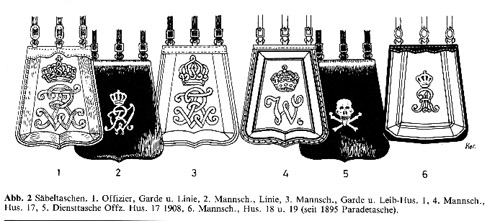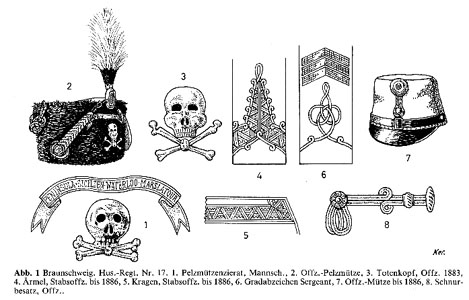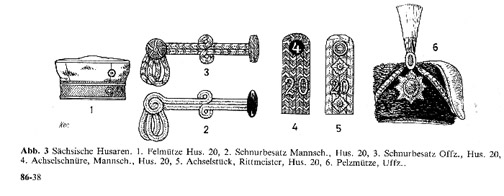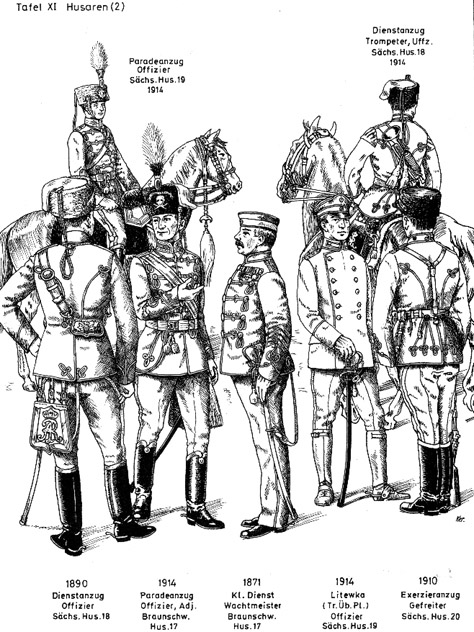
UNIFORMS OF THE ARMY OF THE GERMAN EMPIRE FROM 1870 TO
1914
We contunue here the translation
of articles of Mr. Fritz Kersten published between 1985 and 1990 in the Zeitschrift
für Heereskunde.
We left The Uhlan nr..9 on uniforms of hussars part 1, dedicated to
the Prussian hussars. We tackle the following treating sabretaches,
then uniforms of hussars of the Duchy of Brunswick and lastly the Saxon
hussars. The other states didn't have hussars regiments. I thank again
here MM. Georg ORTENBURG and Dr Frank BAUER of the Gesellschaft Heereskunde
who kindly granted me the authorization to carry on these translations on
Internet. Let's recall that all drawings are M. Fritz Kersten
THE ARMY OF THE GERMAN EMPIRE
THE HUSSARS part 2
Comments on its uniformology from 1871 to 1914
by M. Fritz KERSTEN, translated from Zeitschrift für Heereskunde
h) the sabretachesof
the Prussian hussars
A sabretache made of leather has been attributed to the OR in 1850 it was closed
by a buckle. The flap had the crowned "FWR" monogram in brass or whitemetal
in accordance with the color of braids (fig.2.2).  ).
The hussars of the Garde had their flap covered in red cloth edged of a lace
as well as the monogram and its crown embroidered in yellow lace. The side of
the tray was in red leather (fig.2.3). In 1899, the 1rst Rgt of Leib-Hussars
also received a similar sabretache to the Garde one, but with white lace. Slings
hung to the 3 rings were of red leather for the guard, black for the other Rgts,
with brass buckles. They were suspended to the belt under jacket attila.
).
The hussars of the Garde had their flap covered in red cloth edged of a lace
as well as the monogram and its crown embroidered in yellow lace. The side of
the tray was in red leather (fig.2.3). In 1899, the 1rst Rgt of Leib-Hussars
also received a similar sabretache to the Garde one, but with white lace. Slings
hung to the 3 rings were of red leather for the guard, black for the other Rgts,
with brass buckles. They were suspended to the belt under jacket attila.
The officer's sabretache were in red leather, their flap covered in color
cloth. Lace at the edges as well as the embroidered royal monogram with the
crown were in the color of braiding of the uniform: either gilt or silvery (fig.2.1).
The cloth of Guard hussars and the Rgts. 1, 3, 6, 7, 13 and 14 were ponceau
red, at the 2nd and 5 black, at 4 brown, at the 8 green dark, to the 9 and 12
cornflower blue (kornblumenblau), at 10 light-blue, at 11 dark green, at the
15 and 16 lemon yellow. Slings in black leather had gilt lion heads buckles,
alone the Guard had its slings in red leather.
The position of grappling varied: the lower edge of the sabretache at the base
of the knees in the 1870s, at the end, conforming the regulation, the top of
the sabretache under the bottom of attila jacket.
2
/ THE 17th REGIMENT OF HUSSARS OF BRUNSWICK
In 1867, at the integration of the Duchy in
the Confederation of the North States of Germany, the Ducal hussars Rgt. of
Brunswick received the Nr.17 of the hussar arm. In 1886, at the end of the convention
with Prussia it was integrated into the Prussian army and lost its 'Ducal' title.

a) the Kolback
and the caps
In 1867, the troop received a Kolback of the Prussian model covered of black
bearskin. The bag in red cloth which initially hung on the right passed in 1870
on the left. The Feldzeichen was yellow with a blue center. From 1886 to 1897,
it carried the Prussian Feldzeichen, then in 1914 again the Brunswicker Feldzeichen.
Under the left rosette the non Brunswickers carried their state cockade. From
1886 to 1897, brunswickers other ranks carried the Brunswick cockade on the
left; since 1897, all the Rgt. wore the rosette of the empire on the right.
The chinscales were in brass. As emblem, it carried a scroll with " PENINSULA
SICILIAN WATERLOO ", with, added in 1873 " MARS LA TOUR". The skull and crossbones
was added in 1883 (fig.1.1). The upright parade Haarbusch was white with a light-blue
basis, red for trumpets. In 1886 the Busch became white, with only for non-commissioned
officers the black basis. Trumpeters preserved the previous half-white over
haf red Busch. The Fangschnur cord was yellow for the OR and non-commissioned
officers
The Kolback of officers was also in black bearskin (fig.1.2) even after
1912. The Feldzeichen of the Brunswick colors (golden with center in blue velvet),
was replaced in 1886 by the Prussian Feldzeichen, then in 1897 again by the
Brunswicker Feldzeichen. Mat gilt chinscales were lined of black velvet and
fastend by lion heads instead of rosettes. In 1897, they received the empire
cockade on the left. The headband was matt gilt and the skull of officers and
non-commissioned officers was matt silvered (fig.1.3). In parade officers carried
a Busch in feathers of heron with at the basis a blue cuff, black from 1886,
fixed on a golden basis. The Fangschnur cord in silver was mixed with blue silk,
black from 1886 to 1897, then blue again.
The forage cap was of the Prussian type black with yellow piping at the
top and on the headband (golden for non-commissioned officers, from 1871 only
for the Wachtmeisters and chief of music). In 1886, the headband became red
with a yellow piping as on the top. Before it carried a small cockade in blue
velvet edged in brass. From 1886, it received the Prussian rosette, the Brunswickers
with above it the the Brunswick cockade. In 1897, all the Rgt received the blue
cockade with a yellow circle. A small model of the skull assigned in 1883 on
the kolback, has been added above the headband of the cap. When in 1897, this
one had 2 cockades, the small skull was placed between the cockades.
Officers carried until 1886, a black cap of Austrian type (fig.1.7),
in front with a round golden Feldzeichen with the center in blue velvet carrying
a "W" embroidered in golden thread. Underneath a loop and a golden button. Loop
and lower edge were in golden cord mixed of blue silk. Buttons and the buckle
of the chinstrap in black leather were gilt. In 1886, officers received a black
cap of the Prussian type with red headband and yellow pipings as well as cockades
and the skull.
b) the Attila
jacket
In black cloth with yellow frogging, it fully complied with the Prussian model.
Rosettes were covered of yellow cloth until their replacement in 1886, by the
metallic ones. The Wachmeisters had until 1886 golden braid, instead of wool,
at the collar, the sleeves and shoulders; to the back, as officers, they had
rosettes on clovers .
Frogs of officers' attila were in golden square cord. Plaits on the chest
had a golden knot placed between the buckle and the olive (fig.1.8). As to the
guard's hussars, at the waist in the back, rosettes were placed on clovers and
replaced the olives. Plaits of sleeves in pointed shape were of Austrian type.
Until 1886, staff officers carried Austrian type braids to the collar and sleeves
(fig.1.4 and 1.5); other officers didn't have braid. Straight pockets edged
of braid started from the last rosette to bottom of the jacket. In 1886, officers
received the to sleeves and the collar plaits and braids of Prussian type.
One raises a remarkable oddity: the Brunswickoises closed flaps of their Attila
and their Waffenrock from left onto the right contrary to the Prussian and Saxon
hussars that closed them from right onto the left.
c) the Interimsattila
In black cloth and black woolen braid, placed as on the Prussian Line hussars
attila, olives, rosettes and shoulder buttons covered of black wool. Pockets
without braid edges. The porte-épée ensigns carried the interimsattila in Undress
and out of order but with straps of shoulder of the other ranks. Till the end,
the interimsattila has been officially named "Schwarzer Rock" (black jackett)
in this regiment.
d) breeches and
boots
During the war of 1870, the regiment still rode in the red piped black trousers.
The breeches of the Prussian hussar model only replaced it after the war. Officers
didn't wear gala trousers for official reception.
e) rank badges of the
non-commissioned officers
Until 1886, non-commissioned officers were distinguished by the golden chevrons
on the sleeves (fig.1.6). The NCO. 2, sergeants and ensigns 3, Wachtmeister
and staff trumpets 4 chevrons. As indicated here above, the Wachtmeisters had
golden braid at the collar and sleeves. The Prussian system was introduced in
1886. Sergeants and Wachtmeisters received buttons with the eagle to the collar.
On the greatcoat, Wachtmeisters had shoulder straps with red lining under the
silver plaits mixed blue silk, for NCO a simlilar white braid. From 1886, badges
of the coat were the Prussian type. The sword knot in black leather had for
the non-commissioned officers blue and white mixed acorn and fringes. The Wachtmeisters
had the lion head saber and the Prussian sword-knot yellow and blue decorated.
e) the officers' shoulder
straps
Until 1871, officers had black shoulder straps, then those of the Prussian hussars,
first mixed with blue thread, then in 1886 mixed with black thread .
f) the sabretaches
The flap of the other rank sabretache was covered with red cloth. The braid
of border surrounded it on the four sides. This braid was edged by a light-blue
strip and white toward the outside. The flap was edged on three sides by a yellow
and blue cord. On the middle the monogram ducal "crowned W" was embroidered
in yellow edged of black. A test model shows in 1896, a crown in light-blue
version. The higher side as slings were in red leather.
The officer's sabretache in red leather, had on red cloth rich silver
and gold embroideries of the Austrian type. The monogram was embroidered in
gold and the crown in gold and silver. Staff officers had a larger sabretache
with under the "W" a gold and silver embroidered trophy. Slings in red leather
were covered with a golden braid with thread of red silk in the middle; the
chiseled buckles were gilt. In current duty, the sabretache was protected by
a red leather cover. A service dress sabretache (fig.2.5) in black leather
was introduced in 1908. The embroidered sabretache was saved for the parades.
The flap of the service sabretache carried the silver skull. Slings in black
leather with simple silvered buckles.
3/
THE SAXON ROYAL HUSSARS
....The translation of this
part will come later in Tha Uhlan nr.11. Visit the webpage from time to time……
..... 
COMMENTS TO THE COMPLEMENTARY
DRAWINGS
Plate 11 : Hussars
(part 2)
The barrel sash of the Brunswick
hussars was light-blue, barrels, acorns and knots white. The officers'one,
as in Prussia but dyed in light-blue silk. The troop carried then since 1868,
the M 52 saber, in 1890 the M 89. Officers had the Brunswick cavalry saber with
gilt guard with the sword-knot of the Brunswick infantry pattern. It was replaced
in 1886 by the Prussian officer porte-épée decorated blue and yellow. The lion
head saber was then allowed. Firearms: as for the Prussian Hussars
The 18 and 19 Saxon hussars Rgts
had sashes of Prussian model, but mixed green and white. Saxon Hussar Rgt.
20 carried a brown waist belt with withemetal clasp andh brass-coats of
arms; cartridge-bags and lanyard of brown nature-leather, instead of sash and
pouch belt. As sword, the other ranks got in 1875 the saber M67 (as the Prussian
M52) that they exchanged later for the saber 92. The officers had the Cav.-Officer
Saber M 67 similar to the Prussian 52/79 pattern, in the peacetime also the
lion-head-saber. Firearms like the Saxon Schwere Reiter.
Orders of dress of the hussars

Parade dress: kolback with Busch, attila, with orders and medals, pelisse
(to the regiment with pelisse; the 17th Brunswick Hussar Rgt. had not), sash,
pouch and belt, sabretache, saber, lance,. In winter, the coat on the attila.
Saxon hussar rgt. 20 the sabers to the belt under the attila.
Service dress or order dress:
kolback with rolled cord, attila, in winter pelisse (to rgts with pelisse),
sash, pouch belt, sabretache and saber.
Drill order dress: kolback
(cover, bag and cord according to the command), attila, in winter pelisse (to
rgts with), sash, pouch belt and sabretache able to be left according to the
command. Saber and possibly lance and carbine. Saxon hussar rgt. 20 : belt on
the attila, ammunition pouches and suspenders.
Field service dress: kolback
with cover, cord, attila, in winter pelisse (to rgts with), sash, pouch belt,
sabretache, saber, carbine, lance. Saxon Hussars rgt 20: belt, ammunition pouches
and suspenders. Officers always wore the interimsattila in service
dress; in winter the pelisse Society or Evening dresst: cap (possibly kolback
with bag and rolled), attila, high boots, in summer authorized white long trousers,
in Saxony authorized only in the garrison, saber. White gloves allowed. Saxon
Hussar 20: belt under the attila.
The gray Litewka of 1897
(non-commissioned officers in 1895) had shoulder straps as those of the attila,
collar patches of the color of the attila except to the Rgtses 8 light-blue,
red pompadour 10, yellow 15. To the Hussars rgts. 13 and 16 kornblumenblau collar
patches were edged of a red piping at 13, yellow at 16. At the waist there were
rosettes instead of buttons. The guard had double Litzens, hussars 17 as in
Prussia, huss.18 red collar patches, 19 crimson, Saxon hussar 20 Saxon grey
litewka, feldgrau collar patches with light-blue piping, shoulder straps as
on the attila.
Officer's society dress:
Kolback with rolled cord. Attila, in winter authorized pelisse. Dancers didn't
wear the pelisse to the dance (!!!). Orders and medals. High boots and sabretache.
Gal dress: as in parade. Guard and Rgts 18 and 19 gala breeches elaborately
laced on the thighs in gold or silver, dancers without pelisse nor pouch belt,
but with the sash.
The 1903 officer's Litewka
with piping and collar patches (with a button) of the color of the attila, collar
patches with piping color of the braid. The Leib-hussar no.1 carried patches
in black velvet with white and red pipings. Brunswick Hussar 17 of the Prussian
model, as Hussars 18 and 19. Hussars 20 as hussar 19 but with crowned buttons.
to follow: cavalry, the uhlans
Contents
of the Uhlan on the web
updated on 01/08/2000
![]()
 ).
The hussars of the Garde had their flap covered in red cloth edged of a lace
as well as the monogram and its crown embroidered in yellow lace. The side of
the tray was in red leather (fig.2.3). In 1899, the 1rst Rgt of Leib-Hussars
also received a similar sabretache to the Garde one, but with white lace. Slings
hung to the 3 rings were of red leather for the guard, black for the other Rgts,
with brass buckles. They were suspended to the belt under jacket attila.
).
The hussars of the Garde had their flap covered in red cloth edged of a lace
as well as the monogram and its crown embroidered in yellow lace. The side of
the tray was in red leather (fig.2.3). In 1899, the 1rst Rgt of Leib-Hussars
also received a similar sabretache to the Garde one, but with white lace. Slings
hung to the 3 rings were of red leather for the guard, black for the other Rgts,
with brass buckles. They were suspended to the belt under jacket attila.

